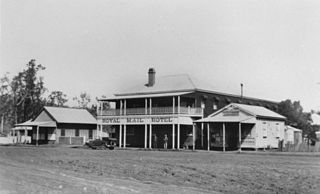Peranga is a rural town and locality in the Toowoomba Region, Queensland, Australia. In the 2021 census, the locality of Peranga had a population of 98 people.
The Cooyar railway line was a branch line in the Darling Downs region of Queensland, Australia. The small town of Cooyar is about halfway to Kingaroy in the South Burnett Region. A plan to connect Kingaroy to the south via Cooyar did not eventuate and left Cooyar at the terminus of a branch line running from Oakey west of Toowoomba.

Cooyar is a rural town and locality in the Toowoomba Region, Queensland, Australia. In the 2021 census, the locality of Cooyar had a population of 231 people.

Quinalow is a rural town and locality in the Toowoomba Region, Queensland, Australia. In the 2021 census, the locality of Quinalow had a population of 205 people.

Aubigny is a rural town and locality in the Toowoomba Region, Queensland, Australia. In the 2021 census, the locality of Aubigny had a population of 283 people.

Maclagan is a rural town and locality in the Toowoomba Region, Queensland, Australia. In the 2021 census, the locality of Maclagan had a population of 130 people.
Kulpi is a rural town and locality in the Toowoomba Region, Queensland, Australia. In the 2021 census, the locality of Kulpi had a population of 77 people.

Boodua is a rural locality in the Toowoomba Region, Queensland, Australia. In the 2021 census, Boodua had a population of 95 people.
Evergreen is a rural town and locality in the Toowoomba Region, Queensland, Australia. In the 2021 census, the locality of Evergreen had a population of 49 people.

Bongeen is a rural locality in the Toowoomba Region, Queensland, Australia. In the 2021 census, Bongeen had a population of 71 people.
Greenwood is a rural locality in the Toowoomba Region, Queensland, Australia. In the 2021 census, Greenwood had a population of 34 people.
Kelvinhaugh is a rural locality in the Toowoomba Region, Queensland, Australia. In the 2021 census, Kelvinhaugh had a population of 49 people.
Nutgrove is a rural locality in the Toowoomba Region, Queensland, Australia. In the 2021 census, Nutgrove had a population of 26 people.
Highgrove is a rural locality in the Toowoomba Region, Queensland, Australia. In the 2021 census, Highgrove had a population of 28 people.
Sabine is a rural locality in the Toowoomba Region, Queensland, Australia. In the 2021 census, Sabine had "no people or a very low population".
Rosalie Plains is a rural locality in the Toowoomba Region, Queensland, Australia. In the 2021 census, Rosalie Plains had a population of 54 people.

Highland Plains is a rural locality in the Toowoomba Region, Queensland, Australia. In the 2021 census, Highland Plains had a population of 60 people.
Mount Darry is a rural locality in the Toowoomba Region, Queensland, Australia. In the 2021 census, Mount Darry had a population of 46 people.
Oakey–Cooyar Road is a continuous 58.8 kilometres (36.5 mi) road route in the Darling Downs and Toowoomba regions of Queensland, Australia. The entire route is signed as State Route 68. It is a state-controlled part regional and part district road. It provides an alternate route between the Warrego Highway and the New England Highway, bypassing Toowoomba.
The roads that join the towns of Dalby, Toowoomba and Cooyar form a triangle that encloses some of the most fertile land on the Darling Downs in Queensland, Australia. These roads are the Warrego Highway, New England Highway and Dalby–Cooyar Road. Pechey–Maclagan Road forms a large part of a group of roads that bisect the triangle from east to west, and is also part of one of the groups of roads that bisect from south to north.







